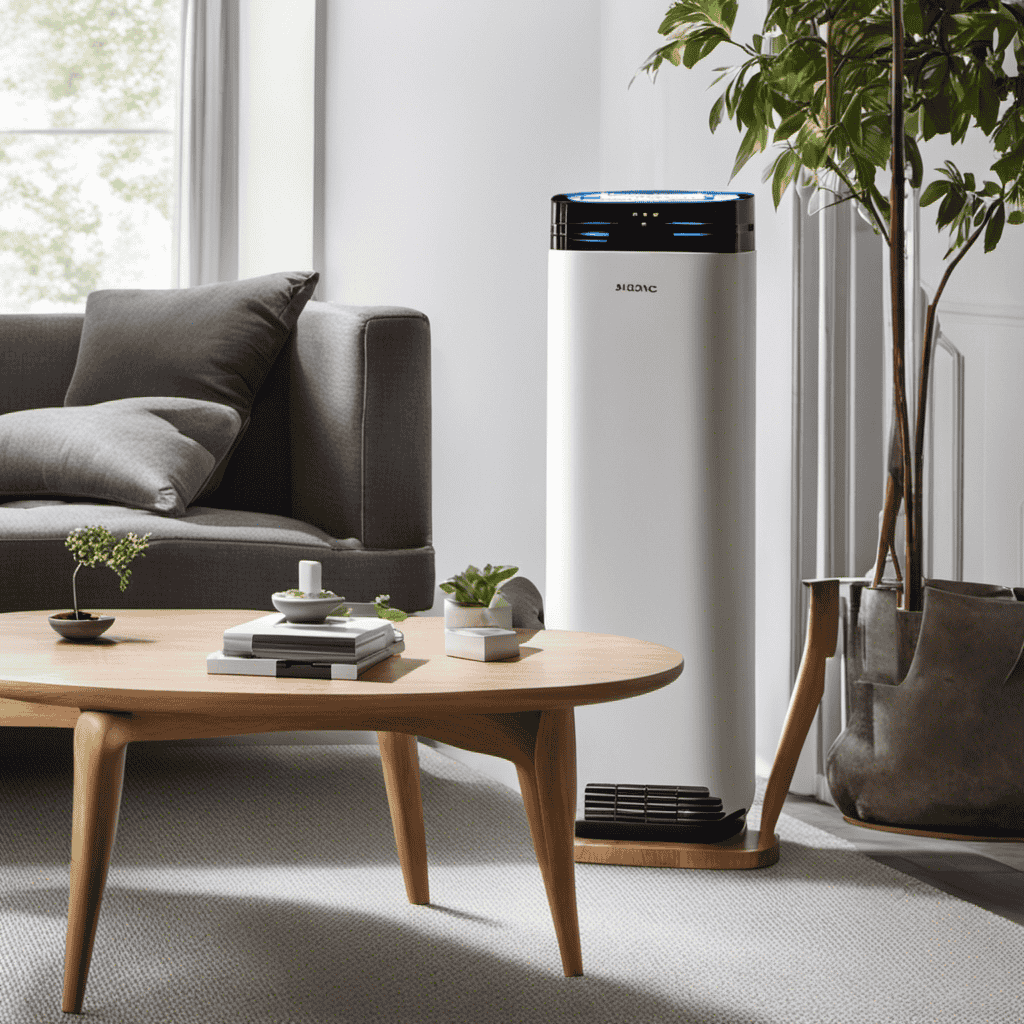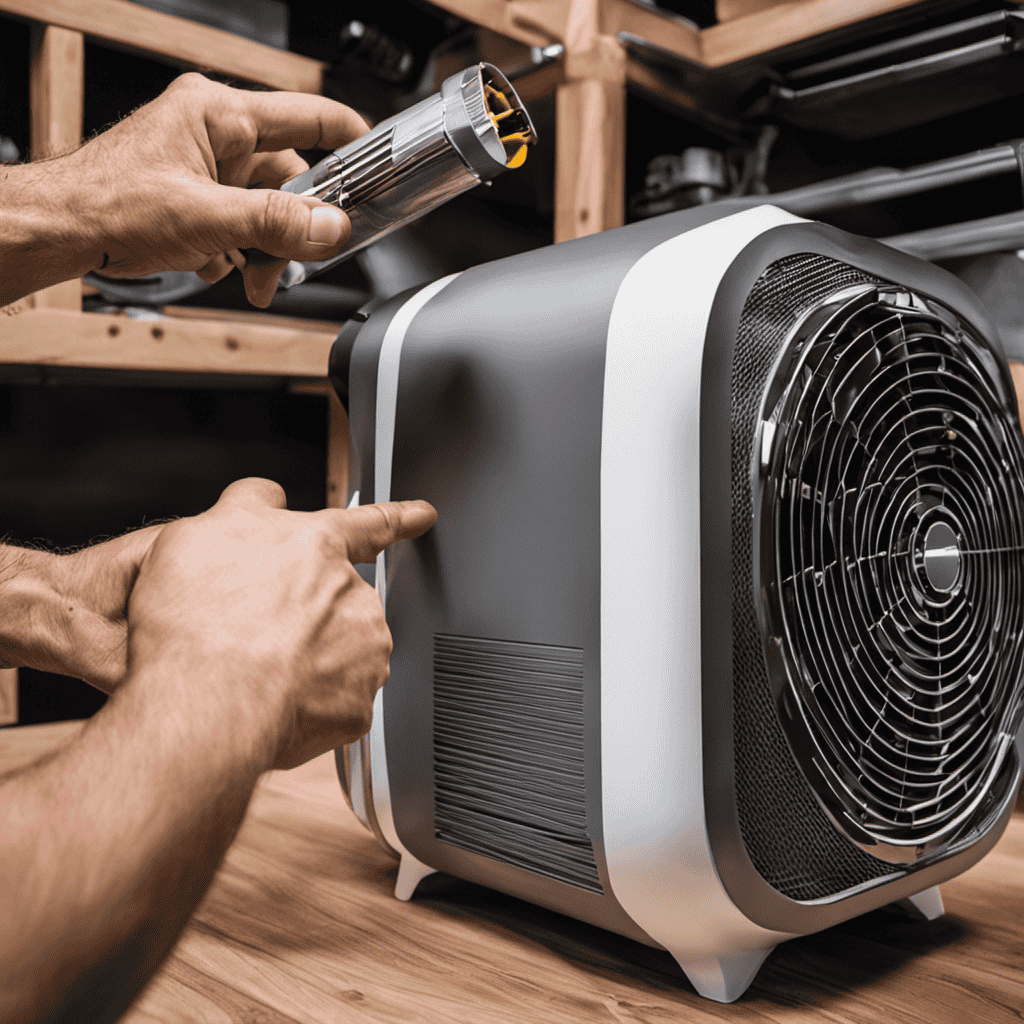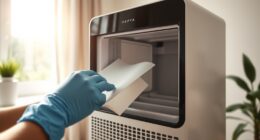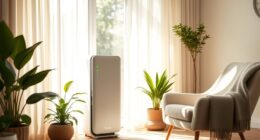When deciding between HEPA and carbon filters, consider your specific needs. HEPA filters excel at capturing allergens like dust, pollen, and pet dander, making them perfect for allergy sufferers. On the other hand, carbon filters tackle odors and harmful gases, ideal for environments with volatile organic compounds or strong smells. If you're concerned about indoor air quality due to allergens, go for HEPA. If you need to eliminate odors from cooking or smoke, carbon is your best bet. Each filter serves a unique purpose, so knowing more about their roles can help you choose the best for your home.
Key Takeaways
- HEPA filters are ideal for reducing allergens like pollen, dust, and pet dander, making them essential for allergy sufferers.
- Carbon filters effectively remove odors and volatile organic compounds (VOCs) from the air, particularly useful in smoke-filled or recently painted spaces.
- Use HEPA filters in areas with high particulate pollution to achieve up to 90% reduction in PM2.5 levels.
- Carbon filters are crucial for environments with strong odors, such as kitchens or near highways, to neutralize harmful gases.
- For comprehensive air purification, consider using both filters together to address both particulate matter and gaseous pollutants.
Overview of HEPA Filters
When it comes to air purification, HEPA filters play an essential role. Standing for High-Efficiency Particulate Air filters, they're designed to remove 99.97% of particles as small as 0.3 microns. This includes common allergens like dust, pollen, and mold spores, making them particularly effective for improving air quality in homes and workplaces.
If you suffer from allergies or respiratory issues, using a HEPA filter can greatly enhance your indoor environment. Additionally, incorporating air purifiers with best performance can further enhance the removal of harmful pollutants.
HEPA filters have a fascinating history, originating during World War II to filter out radioactive particles. Since then, they've been widely adopted in various settings, including healthcare facilities, schools, and HVAC systems.
To maintain their best performance, it's essential to replace your HEPA filters regularly—typically every 6 to 12 months. Some advanced options can even last up to five years, but routine checks are still important.
For the best results, always choose true HEPA filters, as they offer superior filtration capabilities. You'll find them commonly used in air purifiers, vacuums, and air conditioning systems, ensuring your space remains filled with clean, fresh air.
Overview of Carbon Filters

Carbon filters complement HEPA filters by targeting volatile organic compounds (VOCs) and odors that a HEPA filter can't capture. Designed with activated carbon, these filters excel in environments plagued by gas pollutants. They utilize a process called adsorption, which allows them to neutralize various contaminants effectively.
AI security provides robust defenses against various types of threats, similar to how carbon filters tackle specific pollutants in the air.
Here's what you should know about carbon filters:
- They can remove up to 95% of odors related to welding and construction.
- Their porous structure enables chemical reactions with pollutants, enhancing air purification.
- They're particularly useful in indoor areas recently painted or homes with indoor smokers.
- Once the carbon pores are filled, they require replacement for ideal performance.
While carbon filters are excellent for eliminating odors and VOCs, they don't capture particulate matter like dust and pollen.
That's why using them alongside HEPA filters provides thorough air purification, ensuring a cleaner and healthier indoor environment. If you're concerned about air quality, incorporating carbon filters into your setup is a smart choice.
Pollutants Targeted by HEPA
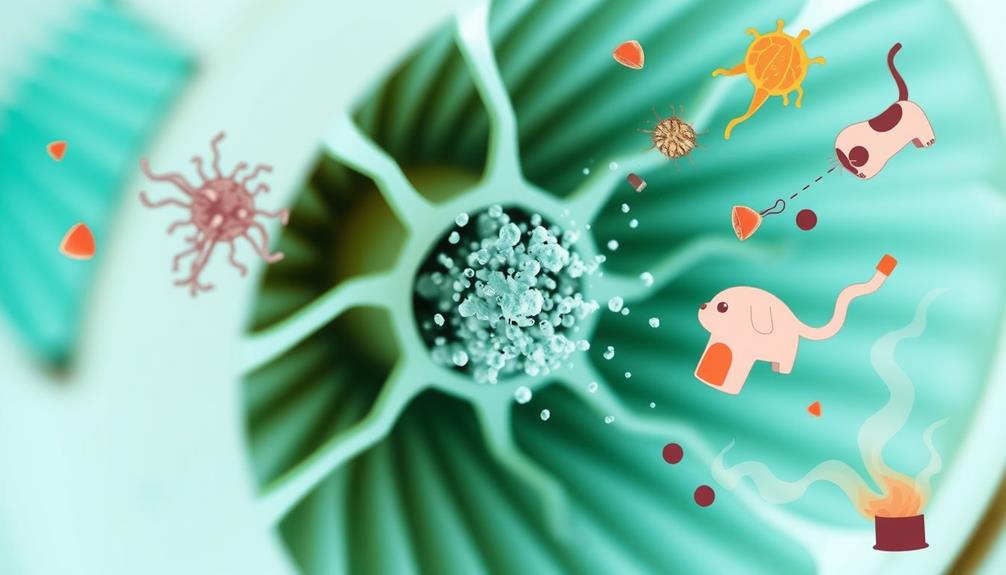
When it comes to air quality, HEPA filters excel at capturing a wide range of pollutants. They can effectively trap particles as small as 0.3 microns, including dust, pollen, and even virus-sized particles.
This capability is particularly beneficial for individuals undergoing lifestyle changes like managing menopause symptoms, as HEPA filters can help create a healthier indoor environment.
Particle Size Efficiency
HEPA filters are impressive when it comes to particle size efficiency, effectively removing 99.97% of particles as small as 0.3 microns. This high efficiency particulate filtration is essential for enhancing your indoor air quality.
By targeting various airborne pollutants, HEPA filters excel at trapping:
- Allergens like pollen and mold spores
- Dust and pet dander
- PM2.5 particles linked to health issues
- Even smaller virus-sized particles
Additionally, incorporating advanced technology in air filtration systems can greatly improve their effectiveness. For example, innovative heat exchangers enhance thermal energy transfer efficiency, which can complement the air cleaning capabilities of HEPA filters.
When you use HEPA filters, you're not just removing particulate matter; you're also creating a healthier environment, especially if you suffer from allergies.
Studies indicate that DIY setups incorporating HEPA filters can achieve a remarkable 90% reduction in PM2.5 levels in just a few hours. This means that if you're seeking a solution to improve your air quality, HEPA filters are a wise choice.
They effectively capture both larger and smaller particles, providing extensive protection against airborne pollutants. With their proven efficiency, HEPA filters stand out as a reliable option for anyone concerned about the quality of the air they breathe.
Common Pollutants Captured
While many air purifiers exist, none capture common pollutants as effectively as HEPA filters. These remarkable filters remove 99.97% of airborne particles as small as 0.3 microns, making them vital for combating allergens and improving air quality. Whether you're dealing with pollen, dust mites, or pet dander, HEPA filters excel at capturing these irritants.
Here's a quick overview of the pollutants targeted by HEPA filters compared to activated carbon filters:
| Pollutant Type | HEPA Filters | Activated Carbon Filters |
|---|---|---|
| Allergens | Pollen, dust mites, pet dander | Minimal capture |
| Mold Spores | Highly effective | Limited effectiveness |
| Volatile Organic Compounds | Poor capture | Effective absorption |
HEPA filters also trap larger particles and even smaller virus-sized particles, offering added protection during cold and flu seasons. In environments with sensitive individuals, like those suffering from allergies or respiratory issues, these filters become essential. While activated carbon filters target volatile organic compounds (VOCs), they can't compete with the thorough pollutant capture that HEPA filters provide.
Health Benefits Considered
Improving your indoor air quality can have considerable health benefits, especially for those sensitive to allergens. By using HEPA filters, you can effectively capture a wide range of pollutants, making your environment healthier and more comfortable.
Additionally, pet owners with dogs can benefit from the reduction of dog health considerations related to airborne allergens. Here are some key advantages of incorporating HEPA filters into your air purification strategy:
- Pollen: Reduces seasonal allergy symptoms by trapping pollen particles.
- Pet Dander: Helps lessen reactions for pet owners by removing dander from the air.
- Dust Mites: Minimizes dust mite allergens, which can trigger respiratory issues.
- Virus-sized Particles: Captures smaller particles, providing extra protection during cold and flu seasons.
While carbon filters excel at removing odors and certain chemicals, HEPA filters specifically target particles that can harm your health.
Regular use of HEPA filters can lead to a cleaner indoor environment, considerably reducing airborne contaminants. This is particularly beneficial in homes and offices where sensitive individuals reside.
As a result, you'll notice a tangible improvement in your air quality, leading to enhanced well-being and overall health benefits.
Don't underestimate the power of HEPA filters in creating a healthier living space!
Pollutants Targeted by Carbon

Carbon filters are essential for removing gaseous pollutants that can harm your health, like volatile organic compounds (VOCs). They effectively target a wide range of contaminants, including formaldehyde and benzene, which may be present in household items.
These filters quickly neutralize odors from smoke, paint, and cooking, making your indoor air fresher. Understanding their efficiency in controlling these pollutants is key to improving your air quality, especially when considering the importance of proper cleaning services for maintaining a healthy environment.
Gaseous Pollutants Removal
Removing gaseous pollutants is essential for maintaining a healthy indoor environment. Carbon filters excel in this area, effectively targeting harmful volatile organic compounds (VOCs) like formaldehyde and benzene, which can have serious health impacts over time.
Additionally, employing hydration strategies, such as using a humidifier, can further enhance air quality by preventing dryness that exacerbates respiratory issues altitude acclimatization to enhance fat burning.
Consider the benefits of using carbon filters for air purification:
- They can reduce VOC levels to zero within minutes in smoke-filled spaces.
- Their adsorption properties capture and neutralize odors, smoke, and chemical fumes.
- They're perfect for high gas pollutant exposure areas, such as kitchens and near highways.
- They help mitigate pollutants from vehicle exhaust, power plants, and forest fires.
While HEPA filters are great for trapping particulate matter, they fall short when it comes to gaseous pollutants.
That's why combining HEPA filters with carbon filters is the best approach. This dual setup guarantees you're not only filtering out dust and allergens but also tackling harmful gases in your air.
Odor Control Efficiency
How effective are carbon filters when it comes to controlling odors in your home? Carbon filters excel at odor control by targeting and removing gaseous pollutants, especially volatile organic compounds (VOCs). These pollutants are often emitted from everyday household products and materials, contributing to unpleasant smells and poor air quality.
For those interested in enhancing their overall wellness at home, incorporating unique mushroom coffee pods can further improve your environment by promoting health benefits.
Through a process called adsorption, carbon filters trap contaminants in the pores of the activated carbon material, allowing for efficient removal of odors. They can effectively eliminate harmful gases like formaldehyde, ammonia, and benzene, which are commonly found in homes.
In smoke-filled environments, carbon filters have demonstrated rapid effectiveness, reducing VOC levels to zero within minutes.
If you frequently deal with cooking fumes, indoor smoking, or nearby industrial emissions, carbon filters are essential for maintaining a fresh indoor atmosphere. Their ability to target and neutralize odors makes them a valuable addition to any home, especially in spaces where strong smells are an issue.
VOCs and Chemical Exposure
Indoor air quality can greatly impact your health, particularly due to the presence of volatile organic compounds (VOCs) found in many household items. These harmful gases are often emitted from products like:
- Paints and varnishes
- Cleaning supplies
- Furniture and carpets
- Air fresheners
Long-term exposure to VOCs, such as formaldehyde, can lead to serious health risks, including respiratory issues and an increased cancer risk. Carbon filters are specifically designed to combat these pollutants. They effectively remove VOCs from the air, enhancing the air quality in your home.
Research shows that certain environmental factors, such as indoor pollutants, can negatively affect both human and pet health, highlighting the importance of using air purification methods, especially in homes with pets like cats who are sensitive to various odors and chemicals.
Utilizing a process called adsorption, carbon filters have a porous structure that reacts chemically with pollutants, neutralizing harmful compounds. In smoke-filled environments, studies show these filters can reduce VOC levels to zero within minutes, making them essential for spaces with high gas pollutant exposure.
This is especially true if you live near highways or in areas affected by forest fire smoke.
When to Use HEPA Filters
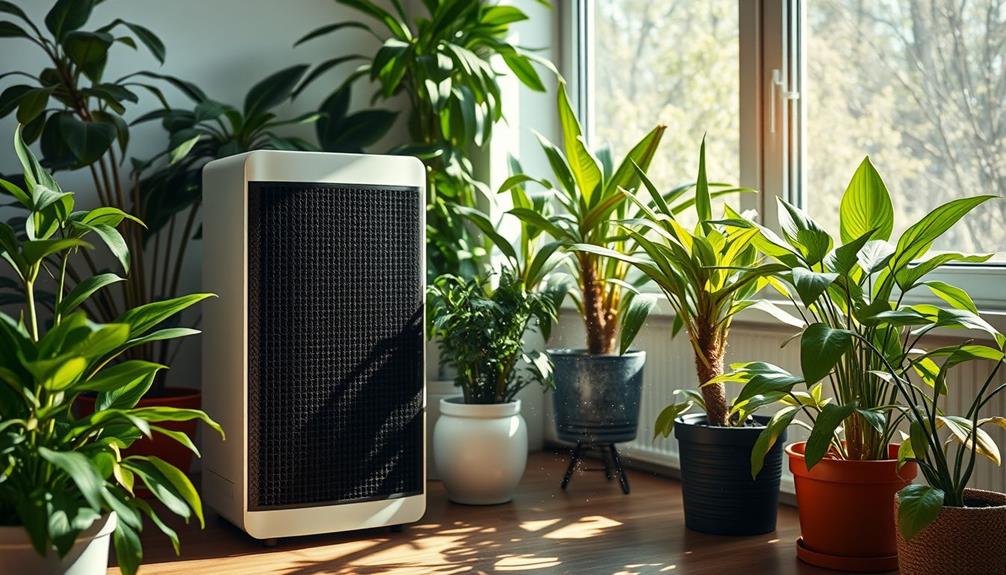
Using HEPA filters can greatly enhance your air quality, especially during cold and flu seasons. These filters capture up to 99.97% of airborne viruses and allergens, making them essential for maintaining healthy indoor air.
If you or anyone in your home has allergies or respiratory issues, installing HEPA filters can notably reduce the presence of pollen, pet dander, and mold spores, creating a safer environment. Additionally, having a reliable home security system can further enhance your indoor safety by protecting against potential intrusions, allowing you to focus on maintaining a healthy home atmosphere.
You should consider using HEPA filters in spaces where air quality monitors indicate elevated levels of particulate pollutants. They're particularly effective in quickly reducing PM2.5 pollutants, achieving up to a 90% reduction within just a few hours when set up correctly.
Regularly using HEPA filters is vital when you notice an increase in indoor allergens or pollutants, ensuring you breathe cleaner air.
Don't forget that to maintain their efficiency, you need to replace HEPA filters every 6-12 months. This practice will help you consistently trap airborne particles and allergens, providing you and your loved ones with the healthiest indoor air possible.
When to Use Carbon Filters

Carbon filters play an essential role in improving air quality, especially in environments where harmful chemicals and odors are prevalent.
They're particularly effective in removing certain smells that cats dislike, such as citrus and vinegar, which may be beneficial for pet owners understanding toxicity to cats from ferns.
You should consider using carbon filters in the following situations:
- After painting or remodeling, to eliminate volatile organic compounds (VOCs) that can linger in the air.
- In homes with indoor smokers, as they effectively neutralize smoke odors and improve indoor air quality.
- Near highways or factories, where exposure to gas pollutants is a concern, helping to reduce harmful emissions.
- In areas affected by forest fire smoke, where they can quickly remove smoke odors and harmful gases.
Conclusion
In the grand tale of air purification, HEPA filters stand as diligent knights, valiantly battling microscopic foes, while carbon filters play the role of wise wizards, conjuring spells to neutralize odors and harmful gases. Depending on your kingdom's needs—be it dust and allergens or smoke and smells—you'll choose your champion wisely. Embrace the strength of both, and you'll create a harmonious domain where clean air reigns supreme, ensuring all who dwell within breathe easy and thrive.



